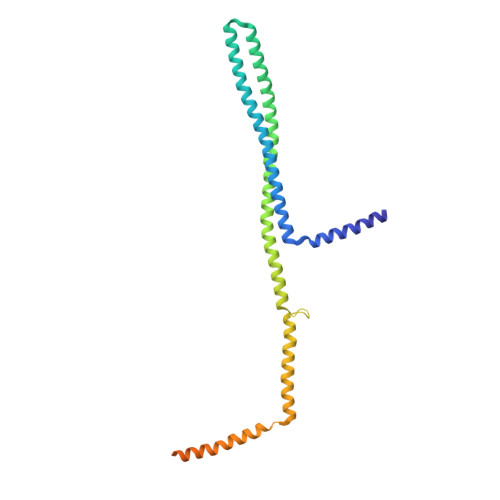Structural basis for VIPP1 oligomerization and maintenance of thylakoid membrane integrity.
Gupta, T.K., Klumpe, S., Gries, K., Heinz, S., Wietrzynski, W., Ohnishi, N., Niemeyer, J., Spaniol, B., Schaffer, M., Rast, A., Ostermeier, M., Strauss, M., Plitzko, J.M., Baumeister, W., Rudack, T., Sakamoto, W., Nickelsen, J., Schuller, J.M., Schroda, M., Engel, B.D.(2021) Cell 184: 3643
- PubMed: 34166613
- DOI: https://doi.org/10.1016/j.cell.2021.05.011
- Primary Citation of Related Structures:
7O3W, 7O3X, 7O3Y, 7O3Z, 7O40 - PubMed Abstract:
Vesicle-inducing protein in plastids 1 (VIPP1) is essential for the biogenesis and maintenance of thylakoid membranes, which transform light into life. However, it is unknown how VIPP1 performs its vital membrane-remodeling functions. Here, we use cryo-electron microscopy to determine structures of cyanobacterial VIPP1 rings, revealing how VIPP1 monomers flex and interweave to form basket-like assemblies of different symmetries. Three VIPP1 monomers together coordinate a non-canonical nucleotide binding pocket on one end of the ring. Inside the ring's lumen, amphipathic helices from each monomer align to form large hydrophobic columns, enabling VIPP1 to bind and curve membranes. In vivo mutations in these hydrophobic surfaces cause extreme thylakoid swelling under high light, indicating an essential role of VIPP1 lipid binding in resisting stress-induced damage. Using cryo-correlative light and electron microscopy (cryo-CLEM), we observe oligomeric VIPP1 coats encapsulating membrane tubules within the Chlamydomonas chloroplast. Our work provides a structural foundation for understanding how VIPP1 directs thylakoid biogenesis and maintenance.
Organizational Affiliation:
Department of Molecular Structural Biology, Max Planck Institute of Biochemistry, 82152 Martinsried, Germany.















